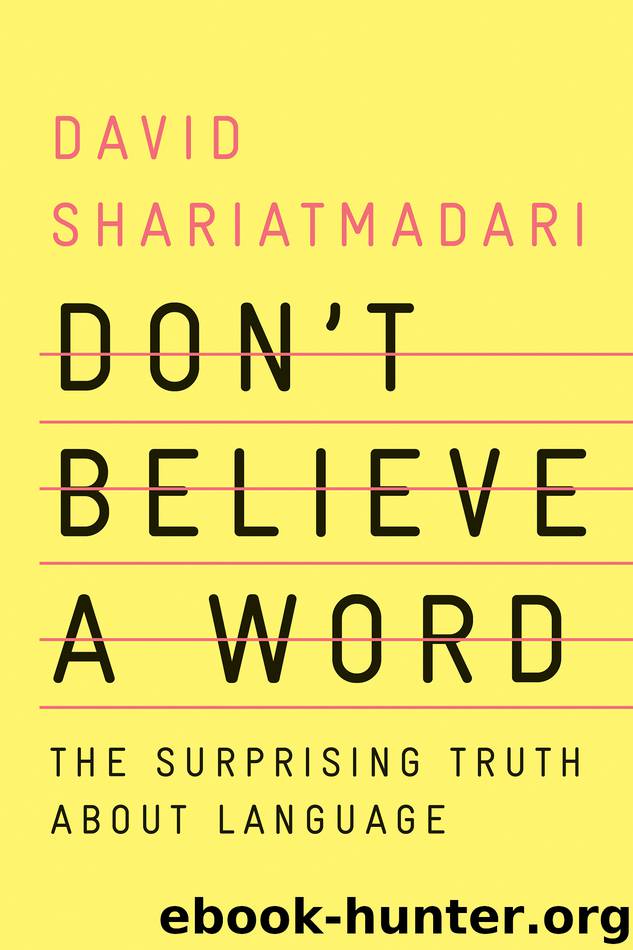Don't Believe a Word: The Surprising Truth About Language by David Shariatmadari

Author:David Shariatmadari
Language: eng
Format: epub
Publisher: W. W. Norton Company
Published: 2019-04-21T23:00:00+00:00
Military matters
So far, we’ve got along without defining the difference between a language and a dialect. There are good reasons for that: it’s often not very clear. Piedmontese, for example, is generally considered a dialect of Italian. But the philologist Auguste Brun described it instead as a language that “did not succeed.” It would be quite reasonable to regard it as a separate entity: it differs from standard Italian in its vocabulary and grammar, and has a long literary tradition. But when Italy was unified in the nineteenth century, a version of Tuscan was adopted as its official language, and the status of Piedmontese was relegated forever to that of dialect. Clearly, that was a political decision. So does the difference between a dialect and a language always come down to politics?
Very often it does. English and Mandarin, say, are obviously completely different. There is no common ground between them save borrowed words,* they evolved in entirely separate parts of the world, and for centuries contact between the two civilizations that used them was limited. But in a situation where the “languages” share a common ancestor and are spoken in close proximity, precisely where you draw the dividing line frequently comes down to power. As one Yiddish-speaking audience member at a lecture by the sociolinguist Max Weinreich famously said (the quote is often attributed to Weinreich himself), “a shprakh iz a dialekt mit an armey un flot”—a language is a dialect with an army and navy. That wisdom largely holds true. The differences between Norwegian, Danish and Swedish are much smaller than the differences between many of the dialects lumped together as “Chinese.” And yet the former are said to be languages, since they belong to three separate nations for whom the differentiation—particularly for the historically poorer, less powerful Norway—is highly significant. Spoken Urdu and Hindi can be indistinguishable from one another, but their status as distinct languages is a point of pride for two nations which have often been on the verge of war.
Arabic offers a mirror image of this. Morocco and Iraq both have an army and navy, and their citizens would have trouble understanding each other in everyday conversation. But they are said to speak dialects of Arabic rather than separate languages. That seems strange until you remember that the religious ties binding the Arab world together are strong. The Quran represents an early standardization of the language, an unchanging model that is revered everywhere Islam is practiced.† Modern standard Arabic, the language of news bulletins and government business, is closely related to that model, and operates as a vehicle for the common Arab identity. But since the geographical range of Arabic is so large, and ordinary people don’t speak like newsreaders, there exists a two-tier linguistic landscape in many Arab countries—something that has been called diglossia, from the Greek for “two” and “tongue.” Modern standard Arabic hovers somewhere above the local varieties, ultimately yoking them all together.‡
This yoking, whether for political or cultural reasons, has been
Download
This site does not store any files on its server. We only index and link to content provided by other sites. Please contact the content providers to delete copyright contents if any and email us, we'll remove relevant links or contents immediately.
| Anthropology | Archaeology |
| Philosophy | Politics & Government |
| Social Sciences | Sociology |
| Women's Studies |
The Code Book by Simon Singh(2217)
The Only Grammar Book You'll Ever Need: A One-Stop Source for Every Writing Assignment by Thurman Susan(1204)
Medea and Other Plays by Euripides(1151)
The Bostonians, Vol. II (Of II) by Henry James(1013)
Social Linguistics and Literacies by Gee James;(920)
The Satyricon by Petronius(842)
Words Fail Me by Patricia T. O'Conner(837)
The Dictionary of the Vulgar Tongue by Francis Grose(780)
The Language Instinct: How The Mind Creates Language by Pinker Steven(751)
The Language Instinct: How the Mind Creates Language by Steven Pinker(717)
The Great Book of American Idioms: A Dictionary of American Idioms, Sayings, Expressions & Phrases by Lingo Mastery(687)
Essential Words for the TOEFL by Steven J. Matthiesen(685)
The Language Instinct by Steven Pinker(658)
Rick Steves Germany 2017 by Rick Steves(656)
The Playboy of the Western World by J. M. Synge(637)
The F-Word by Sheidlower Jesse(631)
The Riddle of the Labyrinth(630)
Wheelock's Latin by Frederic M. Wheelock & Richard A. Lafleur(626)
Don't Believe a Word: The Surprising Truth About Language by David Shariatmadari(626)
